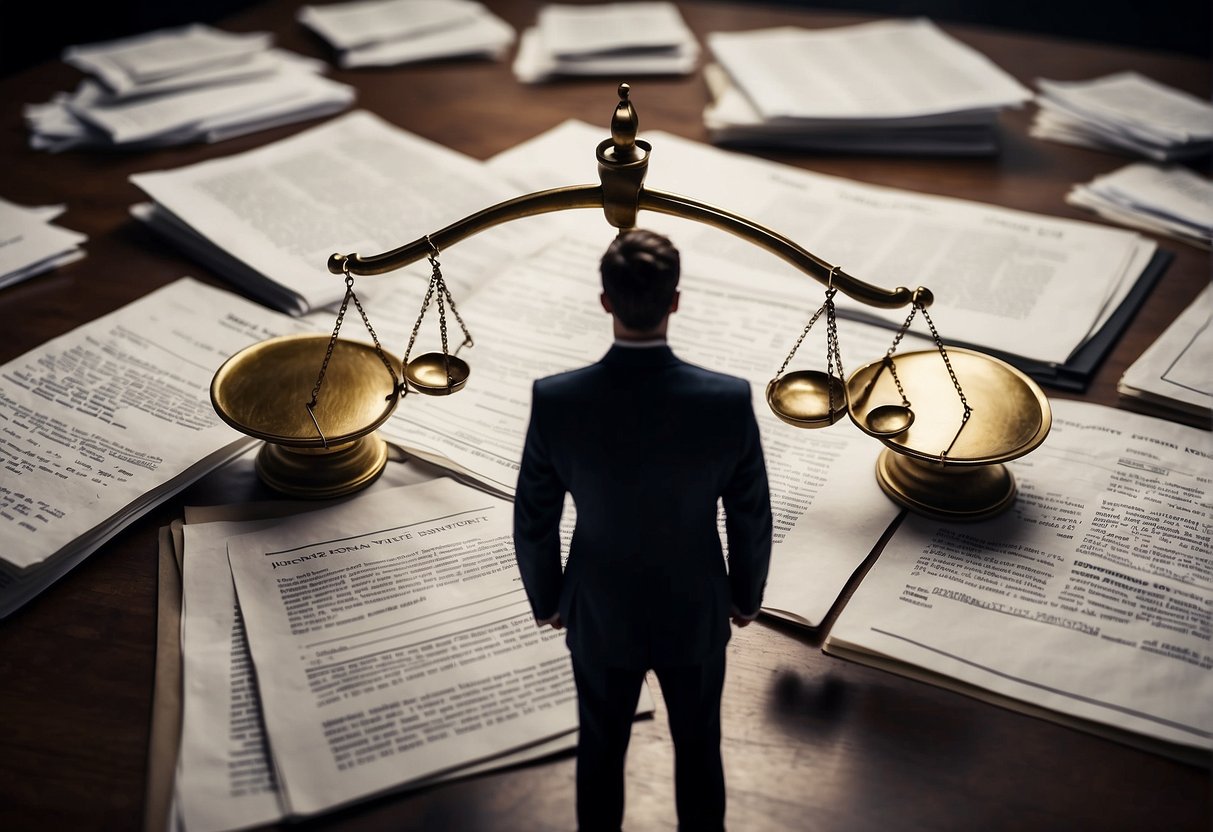Understanding Personal Injury Law
We must grasp the critical concepts of personal injury law, which is structured around the understanding of negligence and duty of care. We often turn to a personal injury attorney for their expertise to navigate these legal waters effectively.

Fundamentals of Negligence and Duty of Care
The cornerstone of personal injury law lies in negligence, which is a failure to exercise the care toward others which a reasonable or prudent person would do in the circumstances, or taking actions which such a reasonable person would not. Negligence is composed of four key elements:
- Duty: We are faced with the concept that every individual has a legal obligation to avoid causing harm to another person.
- Breach: When this duty is not met, it’s considered a breach. It represents a deviation from the standard of reasonable care expected to be followed.
- Causation: The breach of this duty must directly cause an injury or damage to another person.
- Damage: Lastly, there must be actual harm or injury that resulted from the breach of duty.
The assessment of duty and breach is central as it determines whether a person or entity can be held legally responsible for the injury sustained.
Roles of Personal Injury Attorney in Legal Support
Seeking a personal injury attorney is paramount for the injured party to ensure their legal rights are protected. These legal experts perform numerous functions:
- Advocate: A personal injury attorney acts as a staunch advocate for their client, fighting to secure the compensation they deserve.
- Expertise: With their in-depth knowledge of negligence and personal injury law, attorneys offer the necessary expertise to build a solid case.
- Guidance: They navigate the complex legal system and provide guidance on the steps one should take post-injury.
- Representation: In court or during settlements, the attorney represents the client’s interests, leveraging their skills to advocate on their behalf.
A personal injury attorney is instrumental in ensuring that the injured party’s case is heard and that they receive justice for the negligence they’ve endured.
Navigating the Legal Process
When we are injured, understanding the legal process is paramount to securing our rights. We must gather comprehensive documentation and evidence, and be aware of the intricacies involved in litigation and settlements.
Documentation and Evidence Collection
We begin by meticulously collecting all pertinent evidence related to our injury. This involves obtaining:
- Medical records: Our treatment history is crucial.
- Witness statements: These substantiate our account of the incident.
- Photographs of the scene: They serve as visual proof.
- Police reports: If applicable, these add official oversight.
- Incident reports: Reports filed with businesses or properties where the injury occurred.
Adequate evidence is the foundation of our legal claim, and detailed documentation is our best defense in court proceedings.
The Litigation and Settlement Process
Once we initiate a lawsuit, the following steps are generally involved:
- Filing a complaint: Officially stating our claims against the defendant.
- Discovery: Both sides exchange evidence and information.
- Negotiations: Attempting to reach a settlement before trial.
- Trial: If settlement fails, presenting our case in court.
- Verdict: A judgment is made based on the presented evidence.
- Appeal: An opportunity to challenge the court’s decision, if necessary.
Throughout this process, we aim for a resolution that honors our legal entitlements, seeking a settlement that appropriately compensates for our injuries.
Dealing with Insurers and Defendants
When dealing with insurers and defendants, it’s essential to understand claim filing procedures and the intricacies of negotiation for a fair settlement. We must approach these conversations armed with a thorough grasp of our rights and the terms of our insurance policies.
Insurance Claims and Disputes
When filing an insurance claim, we should first meticulously document the incident and our injuries. It’s vital to:
- Contact the insurance company as soon as possible after the incident.
- Review our policy carefully to ensure clarity on coverage.
- Collect and organize evidence such as medical records, accident reports, and witness statements.
In case of a dispute where the insurance company offers an unsatisfactory amount or denies our claim, we need to:
- Compose a detailed letter explaining our position and providing evidence.
- Explore alternative dispute resolution methods, such as mediation.
It may become necessary to consult with a legal representative if the dispute escalates.
Understanding Compensation Negotiation
Negotiation for compensation is a delicate process. Here’s how we should proceed:
- Determine the value of our claim, considering medical expenses, lost wages, and other damages.
- Engage with the defendant or their insurance company with an initial demand that is higher than the amount we’re willing to accept.
- Listen carefully to the counter-offers, being prepared to justify our demand with facts and documentation.
Throughout negotiations, we must remain patient and poised, avoiding hasty agreements. If negotiations stall, or the offers from the defendant or the insurance company are unreasonable, we may decide to take legal action for a fair settlement. Legal counsel can provide strategic advice on when and how to push for a better offer.
Identifying Damages and Seeking Compensation
In this section, we’ll focus on understanding the types of damages that can occur as a result of an injury and the strategies we should employ to ensure that compensation is maximized.
Types of Damages and Their Calculations
When examining types of damages, it’s crucial to differentiate between economic and non-economic damages.
Economic damages are quantifiable costs such as:
- Medical expenses: These include past and future medical treatments.
- Lost wages: Pay that you have lost and will potentially lose due to the injury.
- Property damage: Costs to repair or replace property affected by an incident.
Calculations for these damages are based on actual financial losses. For instance, medical expenses are tallied from medical bills, and lost wages are calculated from salary information.
Non-economic damages cover:
- Pain and suffering: This takes into account the physical discomfort and mental anguish endured.
- Emotional distress: Recognizes the psychological impact of an injury.
These damages are more subjective and often require sophisticated methodologies to assign a monetary value.
Occasionally, punitive damages are awarded to punish egregious misconduct, though not directly related to personal losses.
Strategies for Maximizing Your Claim
To maximize a claim, precise documentation and a strategic approach are imperative. Employ these strategies:
- Compile every related receipt, bill, and statement to substantiate economic damages.
- Maintain a diary to record the daily impact on your life for pain and suffering evidence.
- Work with medical professionals to provide detailed reports linking your condition to the injury for a clear picture of medical expenses.
- Obtain expert testimony to translate the subjective impact of injuries into quantifiable figures for non-economic damages.
Timeliness and completeness in presenting these aspects of your claim are critical in seeking the compensation you rightfully deserve.
Frequently Asked Questions
We understand that navigating legal rights after a personal injury can be complex. Below we’ve outlined answers to frequently asked questions to aid in understanding the process and options available.
What are the key stages involved in a personal injury lawsuit?
When we file a personal injury lawsuit, the stages typically include case evaluation, filing a complaint, discovery, settlement negotiations, trial, and possibly an appeal. Each step requires careful preparation and adherence to legal deadlines and procedures.
What responsibilities does an employer have when an employee sustains an injury at work?
Employers must maintain a safe working environment, provide safety training, and carry workers’ compensation insurance. If an employee is injured, the employer is responsible for reporting the incident and assisting with the claims process for workers’ compensation benefits.
Why is it essential to seek legal representation after sustaining a personal injury?
Legal representation ensures that our rights are protected and maximizes the potential for a favorable outcome. A knowledgeable attorney can navigate the complexities of the law, negotiate with insurance companies, and litigate the case if necessary.
What immediate steps should be taken following a personal injury incident?
Immediately following an injury, we should seek medical attention, document the incident and injuries, and notify the responsible parties. It’s also crucial to consult with a personal injury lawyer to discuss our case and next steps.
Can you outline the different types of injuries that are recognized in civil law?
In civil law, recognized personal injuries can range from physical to psychological. Examples include broken bones, burns, traumatic brain injuries, emotional distress, and chronic pain. These injuries can result from various incidents, such as accidents, assaults, and product malfunctions.
What are the legal remedies available for someone who has suffered a personal injury?
Available legal remedies for a personal injury might include compensatory damages for medical bills, lost wages, and pain and suffering. In some cases, punitive damages are awarded to punish particularly egregious behavior by the at-fault party.




